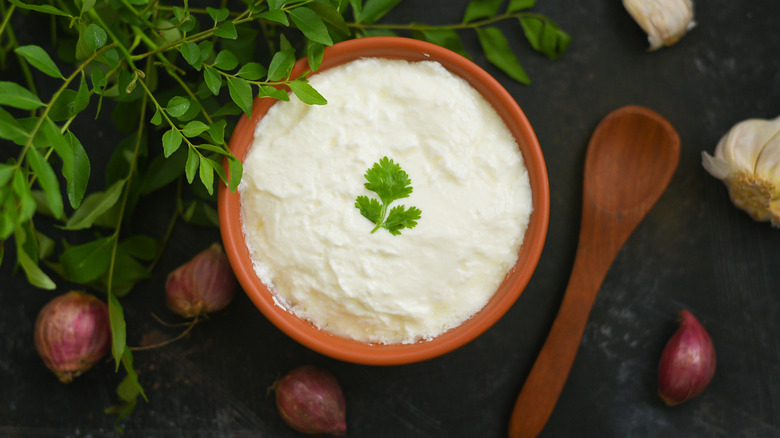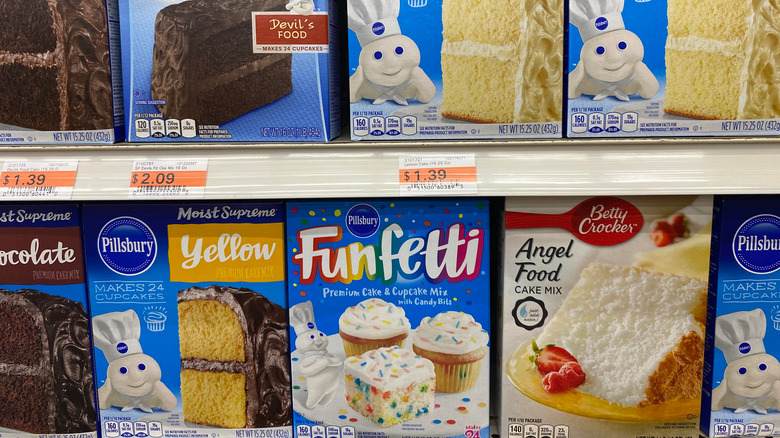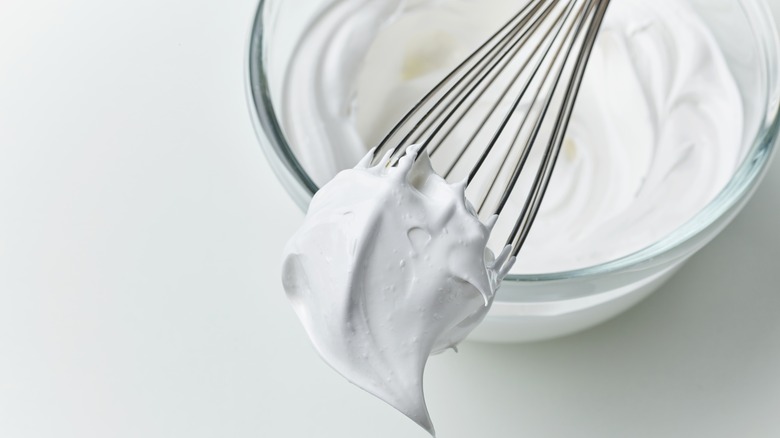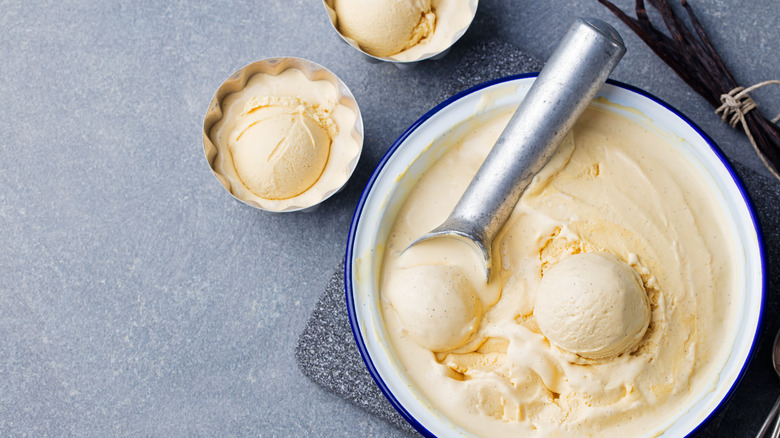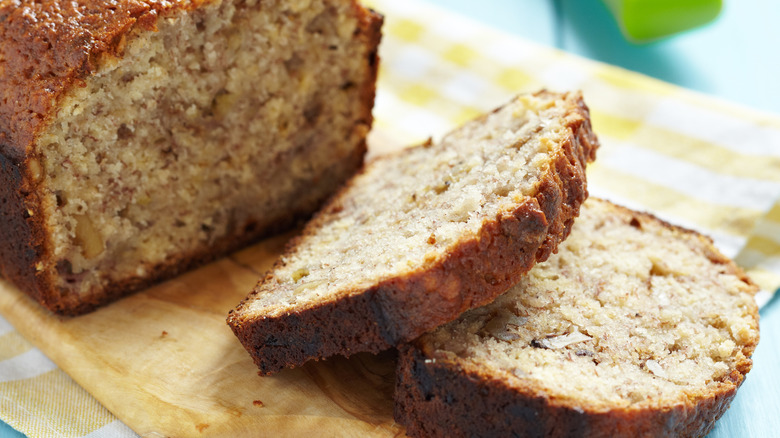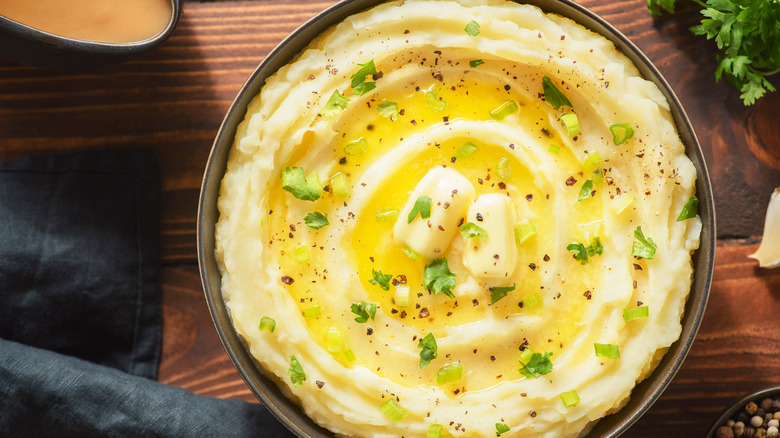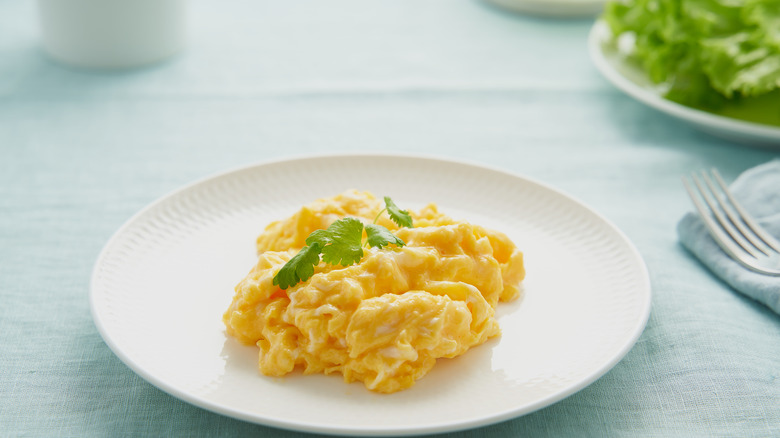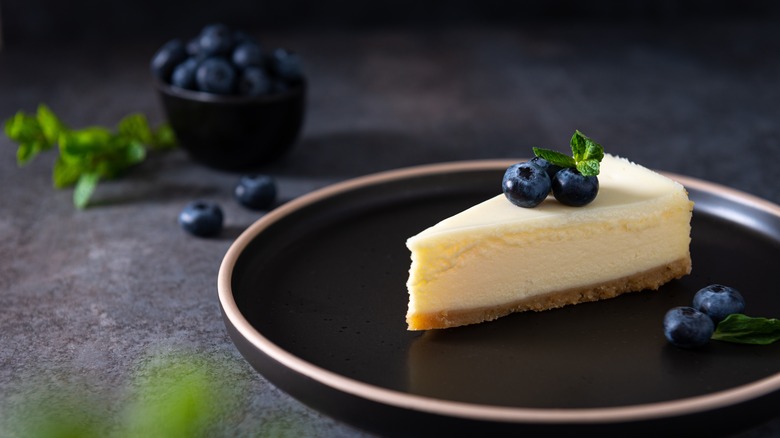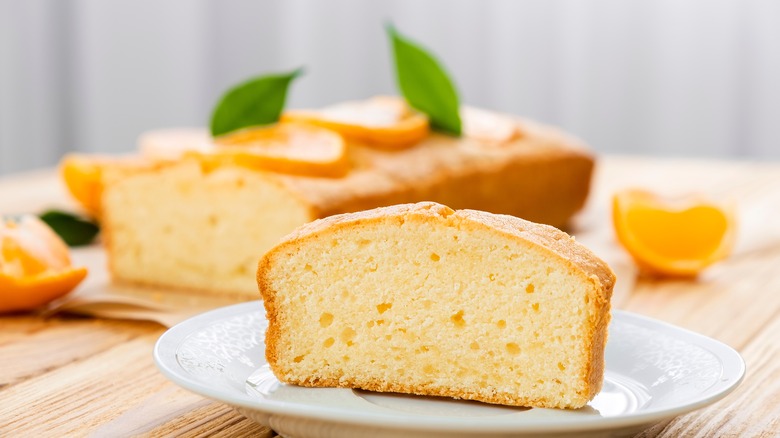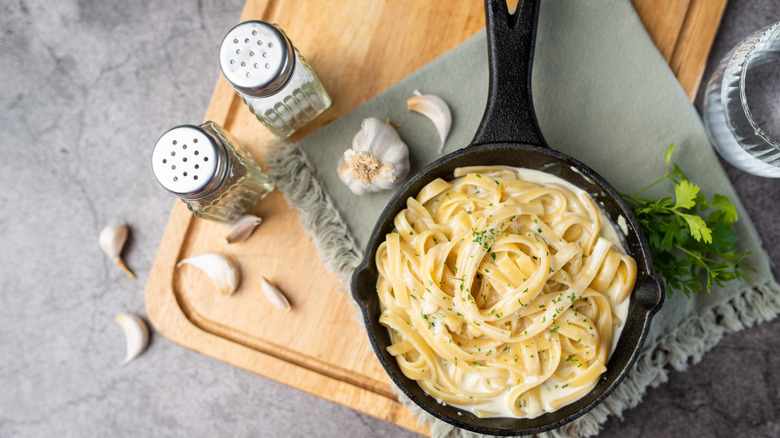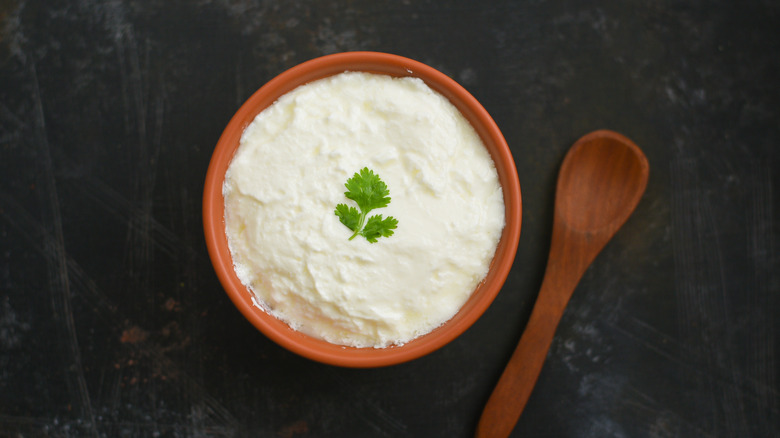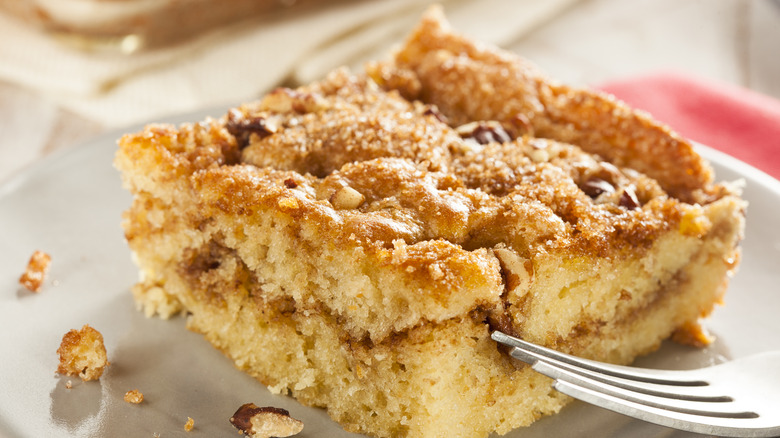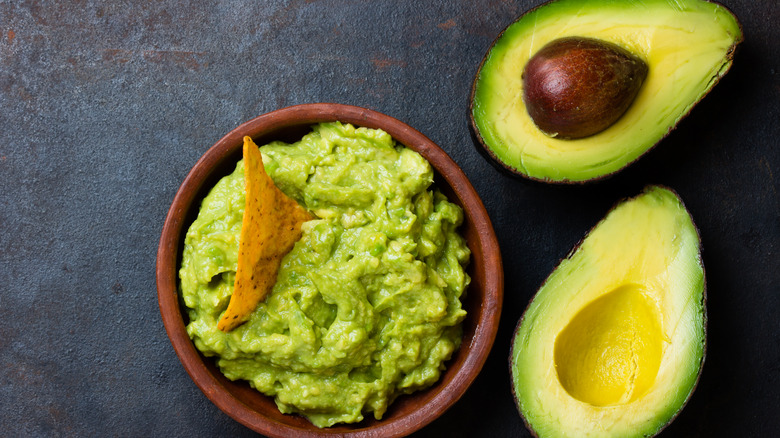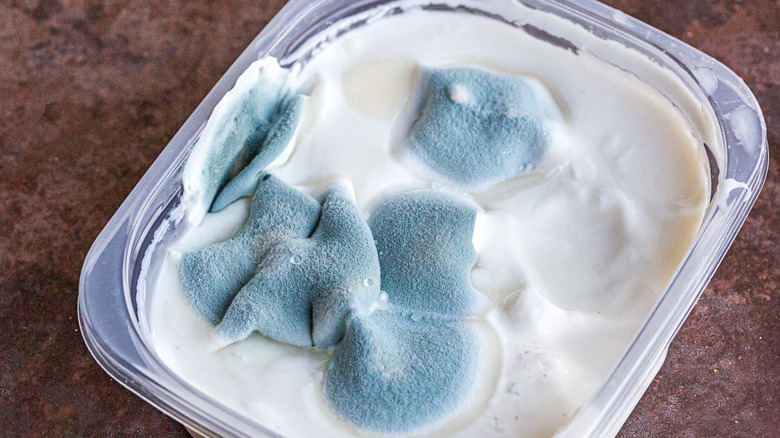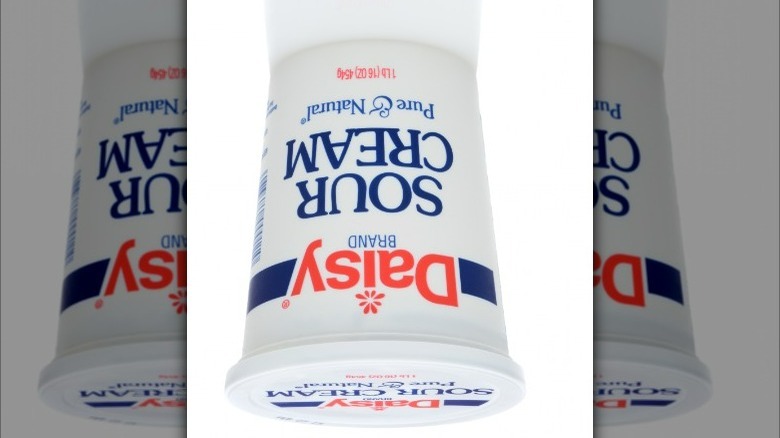15 Tips You Need When Cooking With Sour Cream
What would our world look like without sour cream? Our Chipotle burrito bowls would be much sadder and flavorless — that's for sure. But what exactly is sour cream? This viscous dairy product combines lactic acid-producing bacteria with a dairy-based cream. As the lactic acid bacteria eat the lactose sugar in the cream, they produce a tangy flavor that makes this ingredient perfect for dips, providing a cooling effect to a spicy chili or soup or adding moisture to baked products. You can purchase sour cream in numerous varieties, including light (or reduced fat), fat-free, or even vegan varieties made with a dairy-free cream substitute.
But there's more to sour cream than you might think. Its moisture-inducing properties and distinct flavor make this product perfect for various culinary applications from mashed potatoes and eggs to various baked goods. Here are some essential tips and tricks you need to know when cooking with sour cream.
1. Add it to boxed cake mix
Boxed cake mix can be dull if you don't find ways to spice it up. While it can be a helpful base for birthday cakes and cupcakes, you will get the most utility from the cake mix if you use it as a base. You can amp up the flavors and textures of your boxed cake mix by adding fruit, spices, and extracts, or you can fundamentally change the consistency by adding a dollop of sour cream.
Sour cream is the creamy ingredient that makes boxed cake richer. This is for several reasons. Since sour cream has a high milkfat content of around 18%, the fat shortens the gluten strands and keeps the cake soft. While a bit of gluten helps the cake keep its shape, too much gluten can make it chewy. The tanginess also provides a bit of a flavor boost to the batter. If you're using this hack, you should replace up to a cup of the existing liquid in the recipe using a 1-to-1 ratio. You'll also want to use the full-fat sour cream rather than a lighter option to maximize the textural benefits.
2. Make your whipped cream richer
Whipped cream is perfect for homemade sundaes or atop autumnal apple crisps. And the best part about the sweet topping is that you can make it at home with simple ingredients — heavy cream, vanilla extract, and a pinch of salt — using a stand mixer or a balloon whisk. If you want to elevate your whipped cream, you'll need to include a unique tangy addition. Adding a few tablespoons of sour cream to your whipped cream as you're mixing it will help add a bit of tartness and distract from any other sweeteners you use. You can also fold in the sour cream after you're finished.
Adding sour cream to your whipped cream can also improve its texture. When the cream is whipped, the protein structure in the fat molecules is altered and subsequently bonded together. This creates a more unctuous texture. In addition, the acid and fat of the sour cream addition will further help the whipped cream retain its shape, resulting in a bouncy consistency that is perfect for all kinds of desserts.
3. Scoop it in to homemade ice cream
The root ingredients of ice cream are straightforward: a cooked, cooled, and churned custard base made with heavy cream, half and half, sugar, and vanilla. From there, you can add emulsifiers like eggs for more creaminess or flavorful additions like chocolate, candy bars, and fruit. But the one ingredient you need to make your homemade ice cream shine isn't mentioned in most recipe books.
Sour cream is the tangy ingredient you should add to homemade ice cream. That extra helping of fat will improve the texture of the ice cream, and the nuanced tang can help contrast the sweetness of other ingredients. To add this creamy addition to your ice cream, start by reducing the amount of milk or cream in the recipe. Since sour cream has slightly more fat than milk, you must play with the fat ratios to ensure your ice cream is not too thick or too thin.
4. Maintain the moisture in your banana bread
Banana bread is a deceptively easy food to make. All you need is flour, leavening agents, eggs, fat, and bananas — right? But to make extra delicious banana bread, you'll need to add some ingredients to help the loaf maintain its moisture and soft, plush texture — because no one likes biting into a slice that tastes like it's been sitting on the counter for a few days.
Our extra moist banana bread recipe uses sour cream as a pivotal ingredient to help the loaf stay soft. Like with similar applications, the sour cream helps keep the glutens strands short, which is essential in creating a tender loaf rather than an elastic and chewy one. We've also found that the high-fat content of the sour cream helps reduce the need to add a ton of extra fats and oils that would otherwise make the loaf greasy.
5. Make fluffy mashed potatoes
Sour cream is usually paired with baked potatoes, but we've found that adding it directly into the mix makes a big difference, too. You should use sour cream in your mashed potatoes because it adds a pop of acid to an otherwise dense side dish. In addition, the fattiness from the sour cream eliminates the need to add half-and-half (and potentially butter) to your recipe.
If adding straight sour cream to your potatoes is a little overwhelming, you can thin out the mashed potatoes with a little bit of milk before folding in the creamy addition. It's important to remember that you cannot swap milk out for sour cream in homemade mashed potatoes. Since sour cream is significantly more viscous than milk, you would end up with stodgy mashed potatoes that are difficult to stir. An alternative solution to this problem is to boil your potatoes in milk and add some of the milk back to the potatoes when it comes time to mash them. Then, as the potatoes cook, they will absorb the moisture and be much easier to mash when you add your sour cream.
6. Add a few dollops to scrambled eggs
Scrambled eggs and sour cream are the definition of a dynamic duo. The creaminess and tanginess of the sour cream will elevate the savoriness of your eggs and make for a more satiating breakfast that keeps you filled for longer.
If you're cooking for a crowd, adding sour cream is one way to keep batch-cooked scrambled eggs fresh and velvety. Without the extra addition, you may end up with rubbery eggs. The sour cream helps mellow the texture and offers that fresh-from-the-stove experience — even if your eggs have been sitting on the counter for half an hour. You'll want to add a quarter-cup of sour cream for each dozen eggs you're making after you've removed the eggs from the burner. Alternatively, add sour cream (or crème fraîche for a milder flavor) to the eggs as you scramble or cook them.
7. Give your cheesecake extra tang
Making cheesecake is undoubtedly a labor of love. Classic New York cheesecake, for example, needs to cook in the oven for over five hours and cool for longer. If you spend that much time on a dessert, you surely want it to be the best possible rendition.
There are many reasons why adding sour cream, or another high-fat and high-moisture dairy product, is essential. The fat content of the sour cream helps to ensure a buttery texture to the cheesecake, while its tangy flavor regulates the acidity in the batter. When the lemon juice comes into contact with the fats in the sour cream, it will curdle, thus thickening your cheesecake. Sour cream will provide a slightly thinner cheesecake texture than heavy cream because the former contains about 20% less milk fat. If you don't have access to sour cream, you can substitute it by mixing one cup of heavy cream with one tablespoon of lemon juice.
8. Turn it into homemade butter
Have you ever made homemade butter? It's an experience that sends you back in time to when butter churning was a necessity in households. Now, you just have the convenient option of saving your arm the labor and picking up a pound at the store.
Celebrity chef Alex Guarnaschelli recommends using sour cream in her homemade butter for a tangy taste and smooth texture. She advocates using a sour cream with minimal emulsifiers and gums for the smoothest blend. To make her butter, Guarnachelli whisks sour cream and heavy cream together until the buttermilk starts to separate. She then wraps it in cheesecloth and plunges the butter ball into ice water to harden before covering and storing the log in her refrigerator.
Making butter at home also offers the added benefit of infusing flavors and ingredients to create your unique compound blend. For example, you can prepare sweet cinnamon butter for rolls, herbs for steak, or fruit for a fancy sandwich spread.
9. Keep your pound cake moist
Pound cake is a very dense brick of a cake that is often complemented with whipped cream and fresh fruit. The namesake for this dessert comes from its ingredient list, which at one point was a pound each of butter, flour, eggs, and sugar. But the one ingredient that wasn't included in the original pound cake recipe (but really should have been) is sour cream.
Sour cream is the ingredient that will forever change your classic pound cake recipe because it adds an extra bit of lightness and creaminess to your recipe. You'll want to add the sour cream to your batter towards the end of the preparation process. Cream it together with the vanilla extract and eggs before stirring in the flour. This will ensure that all of your emulsifiers are well-distributed throughout the batter. You'll also want to slowly and deliberately mix the flour into the batter to avoid overdeveloping the gluten.
10. Incorporate it to your creamy pasta sauce
There's nothing more wholesome than a warm bowl (or mug) of macaroni and cheese on a cold day. When it comes to this comfort food classic food and lifestyle icon Martha Stewart has a tip to avoid mealy macaroni and cheese that happens to involve sour cream. Stewart uses whole milk to make a béchamel sauce before combining it with her al dente noodles, decadent layers of cheese, and a sprinkle of cayenne pepper and nutmeg. She then bakes the tray until browned.
But when does the sour cream come in? After spooning the pasta into serving bowls, Stewart then adds a dollop of sour cream. The silkiness of the sour cream pairs well with the dense pasta and helps add lightness to the dish. This is especially important if you're making heavy pasta like macaroni and cheese, which can easily drown you in cheesiness.
11. Make your own sour cream with a few simple ingredients
Since you can buy a container of sour cream from the store for a few bucks, whipping up your own batch might not be on your radar. But if you're all about novel cooking experiences, try making homemade sour cream. You'll only need four ingredients: whole milk, heavy cream, lemon juice, and salt. If you want a thinner sour cream, you'll need a greater proportion of milk and less milk for a thick, spreadable sour cream.
Start by adding the ingredients to a mason jar and shaking for two minutes until the cream thickens. Then, you can let the jar sit for 24 hours in a cool, dark spot to allow the mixture to thicken. Pulling the mixture out prematurely will not develop the thick sour cream texture you're looking for, so it's always better to sit tight and wait for your mixture to be set.
12. Sour cream will keep your coffee cake moist
Close your eyes and picture your ideal slice of coffee cake. It's probably dense, filled with lines and layers of cinnamon and sugar, and covered with a heap of sweet, buttery streusel. There are many variations on coffee cake recipes depending on your preference; some include chocolate, fruit, and nuts.
Sour cream is an ingredient that will make the coffee cake super moist without thinning out the batter too much. The acid and fat in the cream help keep the coffee cake spongey and soft, as well as tenderize the gluten strands in the flour. This gives the impression of a cake that crumbles rather than one with a more bready consistency. We also love adding sour cream to the cake because it contrasts some of the overt sweetness of the strudel and makes for a mild cake that you can enjoy at any time of day.
13. Use sour cream to keep guacamole green
Although brown guacamole is perfectly edible and caused by the oxidation of the fruit over time (similar to apples browning), it is not always the most appetizing thing to eat. Browning can occur rapidly — sometimes within a few hours of the avocado being sliced open. So if you're making guacamole for a crowd or trying to save the other half of your avocado, you should turn to a creamy ingredient to keep your guacamole green: sour cream.
Instead of mixing the sour cream into the guacamole with your onions, salt, and lime, add a thick schmear of the cream to the top of the guacamole or avocado before storing it. Then, wrap the entire thing in plastic to block the moisture. These protective layers will slow the oxidation of your avocado. When you're ready to serve, mash the sour cream back in with the dip for a super creamy guacamole.
14. Look for mold if you think your sour cream has gone bad
How do you tell if food has gone bad? The sniff test is a relatively accurate way to determine if a food has gone sour for most foods. But sour creams naturally — well, sour — odor makes determining if the product has gone bad very difficult. Instead, you can tell if sour cream has gone bad by looking for obvious signs of mold on the top of the sour cream. The odor will also smell slightly different than the good-to-eat stuff.
Sour cream will start showing signs that it is going bad long before the mold spores develop. Once a pool of whey starts to form on the surface of the package, you will only have a couple of days left to use up the rest of it. A sealed container can last one to two weeks past the printed date, while opened sour cream may only have a week to 10 days before it goes south. And like other foods, it is not recommended to scoop out the moldy parts of the container and use the rest, as you cannot see how extensive the mold spore growth is.
15. Turn it upside-down in the fridge to make it last longer
A major qualm we have with sour cream is that it never seems to last that long in the fridge. If you're using a scoop here and there intermittently throughout the week, you'll likely find that it has gone bad before you can use the entire container. While you can certainly bump up your sour cream consumption (after all, is there such thing as adding "too much" sour cream to your baked potato ...), there is another way to help keep your sour cream fresh throughout the week.
Instead of storing your sour cream right-side up, we recommend giving your container a flip. That way, the contents will tip into the empty space in the container, which will slow mold growth there. Just keep in mind that although this hack will make your sour cream last longer in the fridge, it won't preserve its shelf life indefinitely.
Static Media owns and operates Tasting Table, Mashed, and The Daily Meal.
